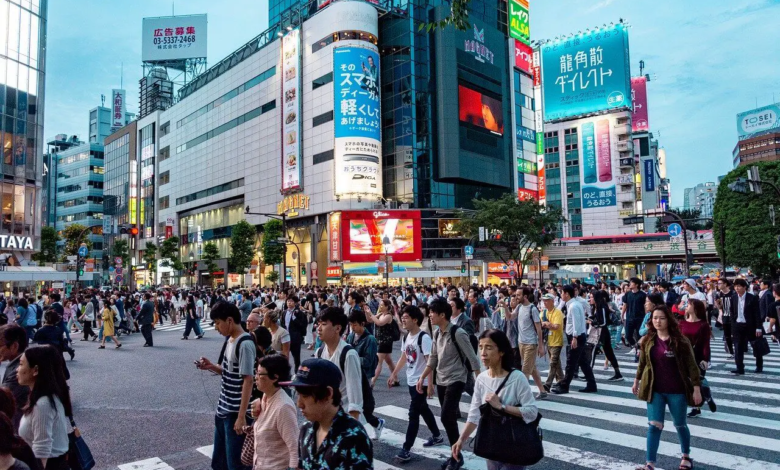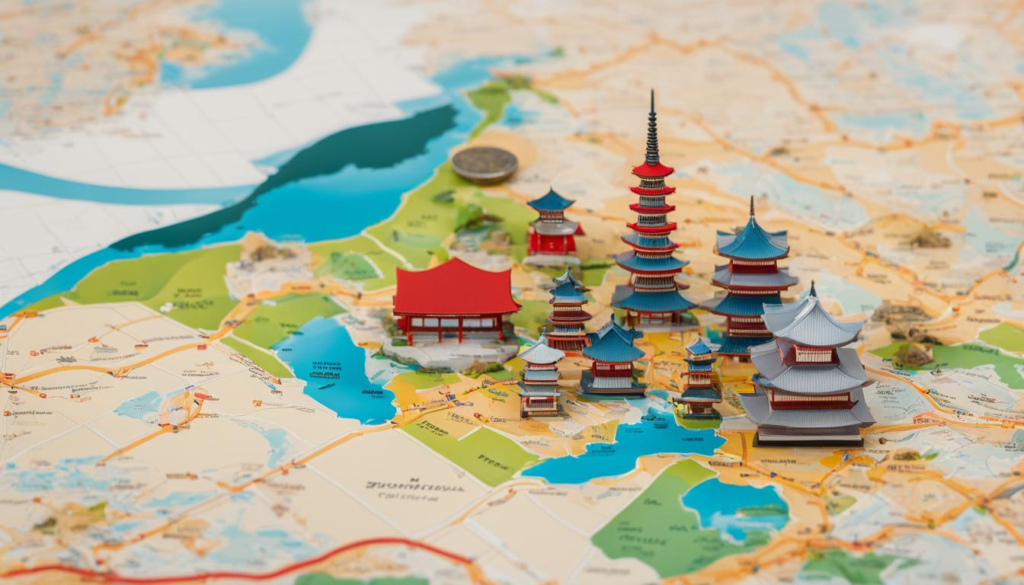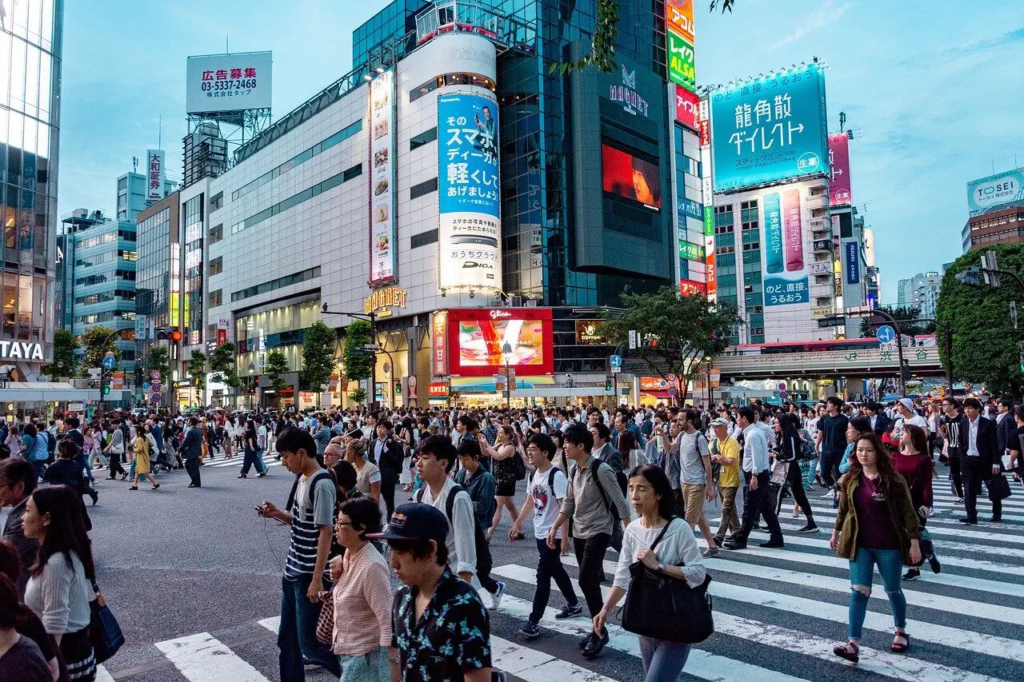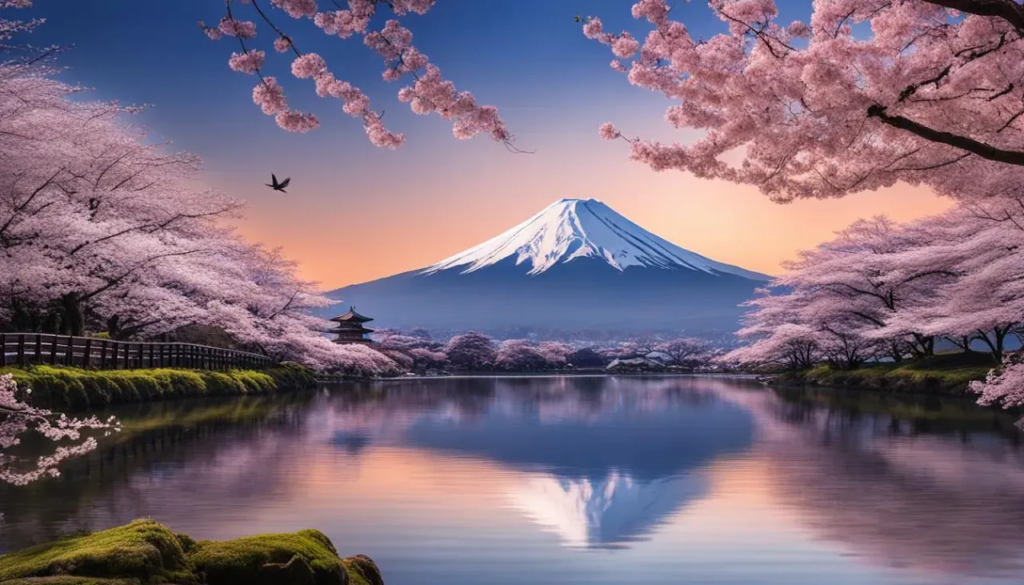Exploring Japan: Unveiling the Delights of Travel and the Rapid Movement Between Cities

Introduction:
Japan, a captivating blend of ancient traditions and futuristic innovations, has long been a favorite destination for travelers seeking a unique cultural experience. With its rich history, breathtaking landscapes, and bustling cities, Japan offers an array of attractions that appeal to all types of adventurers. Moreover, the country’s efficient transportation system ensures seamless travel between its cities, allowing visitors to explore its diverse regions with ease. In this article, we delve into the wonders of travel and tourism in Japan, highlighting the rapid movement between Japanese cities that makes exploring this captivating country a breeze.
Efficient Transportation Infrastructure:
One of the standout features of traveling in Japan is its remarkable transportation infrastructure. The country boasts an extensive network of high-speed trains, efficient local trains, well-connected airports, and an intricate bus system. The renowned Shinkansen, or bullet train, is a symbol of Japan’s commitment to excellence in transportation. These sleek and futuristic trains whisk passengers across the country at speeds of up to 320 kilometers per hour (200 miles per hour), making travel between major cities such as Tokyo, Osaka, Kyoto, and Hiroshima a breeze.
Shinkansen: A Marvel of Speed and Comfort:
The Shinkansen is not only known for its impressive speed but also for its exceptional comfort. Equipped with spacious seating, ample legroom, and onboard amenities, these trains offer a delightful travel experience. Passengers can relax and enjoy the picturesque landscapes that unfold outside their window as they traverse the countryside. The efficiency and punctuality of the Shinkansen are unrivaled, with a remarkable average delay of fewer than 60 seconds. This reliability allows travelers to plan their itineraries with confidence, knowing they will arrive at their destinations promptly.
Local Trains and Metro Systems:
In addition to the Shinkansen, Japan’s local train and metro systems provide convenient transportation within cities and their surrounding areas. Each city has its own network of trains and subways, offering efficient and cost-effective ways to explore local attractions. For example, Tokyo’s intricate metro system covers the entire city and connects seamlessly with neighboring regions, making it effortless to navigate the vast metropolis.
Air Travel: Connecting the Distant Corners:
For those seeking to cover large distances in a short time, domestic air travel is an excellent option. Japan has a well-developed network of airports, both international and domestic, ensuring easy access to popular tourist destinations. Airlines such as Japan Airlines (JAL) and All Nippon Airways (ANA) offer a plethora of domestic flights, allowing travelers to reach even the most remote parts of the country quickly.
Exploring Japanese Cities:
Japan’s cities are a melting pot of ancient traditions and modern marvels. Each city boasts its own unique charm and attractions, making it worthwhile to explore multiple destinations during a visit. From the neon-lit streets of Tokyo to the historic temples of Kyoto and the vibrant food scene in Osaka, every city offers a distinct experience. Thanks to Japan’s efficient transportation system, travelers can hop between cities effortlessly, maximizing their time and experiencing the country’s diverse offerings.
Conclusion:
Traveling in Japan is a delight for both adventure enthusiasts and culture seekers. The country’s efficient transportation infrastructure, epitomized by the iconic Shinkansen, ensures rapid movement between cities, making it possible to explore Japan’s diverse regions with ease. Whether you’re captivated by the bustling streets of Tokyo, the serene beauty of Kyoto’s temples, or the vibrant nightlife of Osaka, Japan’s cities offer a plethora of attractions waiting to be discovered. So, pack your bags, embark on an unforgettable journey, and let Japan’s efficient travel system take you on an adventure of a lifetime.

Let’s delve deeper into the fascinating aspects of travel and tourism in Japan, focusing on the cities and the rapid movement between them.
- Tokyo: The Vibrant Metropolis
Tokyo, Japan’s capital, is a city that never sleeps. It’s a sprawling metropolis known for its cutting-edge technology, vibrant street fashion, and bustling cityscape. Visitors can explore iconic landmarks such as the Tokyo Skytree, Shibuya Crossing, and the historic Imperial Palace. The city also offers a wide range of shopping districts, from luxury brands in Ginza to trendy boutiques in Harajuku. With its efficient metro system and numerous train lines, navigating Tokyo is a breeze, allowing travelers to easily explore its various neighborhoods and attractions. - Kyoto: A Glimpse into Japan’s History
Known for its rich cultural heritage and traditional architecture, Kyoto is a city that captivates with its beautiful temples, serene gardens, and geisha culture. Travelers can visit iconic sites like Kinkaku-ji (Golden Pavilion), Fushimi Inari Shrine with its thousands of vermillion torii gates, and the historic district of Gion, where geisha can still be spotted. Kyoto’s local train system and bus network provide easy access to its numerous attractions, allowing visitors to immerse themselves in the city’s ancient charm. - Osaka: The Culinary Paradise
Osaka, often called the “Kitchen of Japan,” is renowned for its vibrant street food scene and lively atmosphere. The city offers a plethora of culinary delights, from delicious takoyaki (octopus balls) and okonomiyaki (savory pancakes) to mouthwatering sushi and sashimi. Beyond food, Osaka boasts attractions like Universal Studios Japan, Osaka Castle, and the bustling Dotonbori district. Its efficient subway system and local train lines make getting around Osaka and its surrounding areas convenient for travelers. - Hiroshima: A Lesson in Resilience
Hiroshima, a city with a profound history, serves as a poignant reminder of the devastating impact of the atomic bomb during World War II. Today, Hiroshima stands as a symbol of peace and resilience, offering visitors the opportunity to learn about the city’s past and explore its peaceful parks and memorials. The Hiroshima Peace Memorial Park and the Hiroshima Peace Memorial Museum provide a sobering yet essential experience. Travelers can easily reach Hiroshima via the Shinkansen, making it a popular day trip destination from other major cities like Kyoto or Osaka. - Rapid Movement with the Japan Rail Pass
To facilitate travel between cities, Japan offers the Japan Rail Pass (JR Pass), a cost-effective option for foreign visitors. The JR Pass provides unlimited access to Japan’s extensive rail network, including the Shinkansen, JR trains, and some local lines. Travelers can choose from various pass durations, allowing them to explore multiple cities without the hassle of purchasing individual tickets. The JR Pass is particularly advantageous for those planning to visit different regions of Japan. - Beyond the Major Cities
While Tokyo, Kyoto, Osaka, and Hiroshima are popular destinations, Japan has much more to offer beyond these urban centers. From the natural beauty of Hokkaido in the north to the historical sites of Nara and the picturesque landscapes of Miyajima Island, there are countless hidden gems waiting to be discovered. Japan’s efficient transportation system ensures that even remote areas can be easily accessed, allowing travelers to explore the diverse landscapes and immerse themselves in local traditions.
Japan’s cities offer a fascinating blend of ancient traditions, modern innovations, and unique cultural experiences. The country’s efficient transportation infrastructure, including the iconic Shinkansen and well-connected local train systems, enables travelers to move rapidly between cities, maximizing their exploration opportunities. Whether you’re drawn to the bustling streets of Tokyo, the serene beauty of Kyoto, the culinary delights of Osaka, or the historic significance of Hiroshima, Japan’s cities promise unforgettable experiences and a journey through the heart of this captivating country.

Here are some additional aspects to explore when it comes to travel and tourism in Japan and the rapid movement between cities:
- Regional Specialties and Local Culture:
One of the joys of traveling in Japan is discovering the unique regional specialties and local culture that vary from city to city. Each region is known for its distinct culinary delights, traditional crafts, festivals, and historical landmarks. For example, Hokkaido is renowned for its fresh seafood and winter sports, while the Kansai region (which includes Kyoto and Osaka) is famous for its traditional tea ceremonies and historic temples. By exploring different cities, travelers can immerse themselves in the local culture and experience the diverse flavors and traditions of Japan. - Day Trips and Nearby Attractions:
Japan’s efficient transportation system makes it convenient to take day trips from major cities to nearby attractions. For instance, from Tokyo, travelers can easily visit Nikko, known for its beautiful shrines and natural scenery, or the hot springs in Hakone. From Kyoto, a short train ride can take you to Nara, home to friendly deer and ancient temples, or Hiroshima, where you can visit the iconic Itsukushima Shrine on Miyajima Island. These day trips allow visitors to expand their itineraries and explore more of Japan’s treasures. - Hidden Gems and Off-the-Beaten-Path Destinations:
While major cities like Tokyo and Kyoto have their well-known attractions, Japan is full of hidden gems and off-the-beaten-path destinations waiting to be discovered. From quaint rural villages to scenic coastal towns, there are countless lesser-known places that offer a glimpse into authentic Japanese life. These hidden gems can be easily accessed using Japan’s transportation network, allowing travelers to venture off the typical tourist path and create unique and memorable experiences. - Overnight Stays and Ryokans:
To fully immerse yourself in Japanese culture and experience traditional hospitality, consider staying overnight in a ryokan—a traditional Japanese inn. Ryokans offer a unique blend of comfort, tranquility, and cultural immersion. Guests can enjoy sleeping on futon mattresses, relaxing in communal hot spring baths (onsen), and indulging in delicious kaiseki meals showcasing seasonal ingredients. Many ryokans are located in scenic areas outside major cities, providing an opportunity to experience the natural beauty of Japan while enjoying the warm hospitality of the locals. - Seasonal Beauty and Festivals:
Japan’s distinct seasons offer an ever-changing landscape and a variety of seasonal activities and festivals. From cherry blossoms in spring to vibrant autumn foliage, each season has its own charm. Cities like Kyoto and Takayama are particularly renowned for their stunning cherry blossom displays, while cities such as Sapporo and Aomori host winter festivals featuring intricate ice sculptures and traditional performances. Travelers can plan their visits based on the seasons to witness Japan’s natural beauty and partake in local festivals.
:
Traveling in Japan is an adventure that goes beyond the major cities. The country’s efficient transportation system allows visitors to easily explore regional specialties, discover hidden gems, and experience the rich cultural heritage that Japan has to offer. Whether it’s savoring local cuisine, participating in traditional festivals, or embarking on day trips to nearby attractions, Japan’s rapid movement between cities ensures that travelers can create a well-rounded itinerary that encompasses the diverse and captivating aspects of this fascinating country.
https://hilton.tp.st/qbgQTbU2

further into additional aspects of travel and tourism in Japan, focusing on unique experiences, accommodations, and transportation options:
- Unique Experiences:
Japan offers a plethora of unique experiences that cater to different interests and preferences. Nature enthusiasts can explore the stunning landscapes of places like the Japanese Alps, where they can hike through picturesque trails and soak in hot springs. Animal lovers can visit the famous snow monkeys in Jigokudani Monkey Park or go whale watching in Hokkaido. For those seeking spiritual enlightenment, a visit to Mount Koya, a sacred Buddhist mountain, offers the chance to stay in a temple lodging (shukubo) and participate in morning prayers and meditation. These one-of-a-kind experiences allow travelers to delve deeper into Japan’s natural beauty, wildlife, and spiritual practices. - Accommodations:
In addition to ryokans, Japan offers a wide range of accommodation options to suit different budgets and preferences. From luxury hotels in bustling cities to traditional machiya townhouses in Kyoto, capsule hotels for a unique experience, and Minshuku (family-run guesthouses) in rural areas, there is something for everyone. Staying in a traditional Japanese-style room with tatami mats, futon beds, and paper sliding doors provides an authentic experience, while modern accommodations offer convenience and comfort. Japan’s cities offer a wide variety of accommodations, ensuring that travelers can find the perfect place to rest and rejuvenate after their adventures. - Transportation Options:
While the Shinkansen is the most iconic mode of transportation in Japan, there are other options worth exploring. Domestic flights are an excellent choice for those who want to cover long distances quickly, especially when traveling from one end of the country to the other. Japan’s domestic airlines offer efficient and reliable service, allowing travelers to reach their destinations swiftly. Additionally, Japan’s extensive bus network is an economical way to travel between cities, especially for those on a budget. Long-distance highway buses provide comfortable seating and often feature amenities like WiFi and power outlets. - Cultural Exchanges and Workshops:
Japan offers opportunities for cultural exchanges and immersive workshops, allowing visitors to learn traditional arts and crafts directly from skilled artisans. From tea ceremonies and ikebana (flower arrangement) classes to calligraphy workshops and samurai sword demonstrations, these experiences provide a deeper understanding of Japanese culture and a chance to acquire new skills. Many cities, such as Kyoto and Tokyo, have dedicated cultural centers and studios where visitors can participate in these workshops and engage with local experts. - Local Cuisine and Food Tourism:
Japan is a food lover’s paradise, and exploring the country’s culinary offerings is a must-do. Each region in Japan has its own specialty dishes and local ingredients. From the freshest sushi in Tsukiji Fish Market in Tokyo to the hearty ramen in Fukuoka, the regional cuisines offer a delightful journey for the taste buds. Food tours and cooking classes provide opportunities to learn about Japanese cuisine, sample local delicacies, and even try your hand at making traditional dishes like sushi, tempura, or wagashi (traditional sweets).
:
Japan offers an abundance of unique experiences, diverse accommodations, and various transportation options that cater to different interests and budgets. Whether it’s immersing oneself in nature, staying in traditional lodgings, participating in cultural workshops, or indulging in the country’s delectable cuisine, Japan’s travel and tourism scene has something for everyone. Exploring beyond the major cities opens up a world of hidden treasures, local traditions, and unforgettable experiences, allowing travelers to create lasting memories in this captivating country.

https://discovercars.tp.st/i9BtiprC
Here are some additional aspects to explore when it comes to travel and tourism in Japan:
- Onsen Culture:
Onsen, or hot springs, play a significant role in Japanese culture and are popular tourist attractions. Japan is known for its abundance of natural hot springs, which are believed to have therapeutic properties. Travelers can relax and rejuvenate in these soothing thermal baths, surrounded by beautiful landscapes. Some notable onsen destinations include Hakone, Beppu, and Kusatsu. Many ryokans and hotels offer onsen facilities, allowing guests to immerse themselves in this traditional practice. - Outdoor Activities:
Japan’s diverse topography provides ample opportunities for outdoor activities. Adventure seekers can go hiking in the Japanese Alps, climbing Mount Fuji, or exploring the stunning trails of Yakushima Island. Water sports enthusiasts can enjoy snorkeling or diving in Okinawa’s crystal-clear waters, while winter sports enthusiasts can hit the slopes in popular ski resorts like Niseko or Hakuba. Japan’s varied landscapes cater to a wide range of outdoor pursuits, ensuring there’s something for every adventurer. - Anime and Pop Culture:
Japan has a vibrant pop culture scene that has gained international recognition. Fans of anime, manga, and gaming can explore the bustling districts of Akihabara in Tokyo and Nipponbashi in Osaka, known as “geek meccas,” where they can find an array of shops selling merchandise, themed cafes, and gaming centers. Additionally, events like Comiket (Comic Market) and AnimeJapan attract enthusiasts from around the world. Visiting these destinations allows travelers to immerse themselves in the world of Japanese pop culture. - Gardens and Parks:
Japan is renowned for its meticulously designed gardens and serene parks. These green spaces offer a tranquil escape from the bustling cities. In Kyoto, the famous Kiyomizu-dera Temple and its surrounding gardens captivate visitors with their natural beauty. Tokyo’s Shinjuku Gyoen National Garden and Osaka Castle Park are popular spots for cherry blossom viewing in spring. Exploring these gardens and parks allows travelers to appreciate the artistry and serenity of Japanese landscaping. - Temples and Shrines:
Japan is home to countless temples and shrines, each with its unique architectural style and historical significance. The Fushimi Inari Shrine in Kyoto, with its thousands of torii gates, is a must-visit attraction. The Todai-ji Temple in Nara houses the Great Buddha, one of Japan’s largest bronze statues. Travelers can also explore the iconic Senso-ji Temple in Tokyo or the Itsukushima Shrine in Hiroshima, known for its “floating” torii gate. These sacred sites provide insights into Japan’s spiritual heritage and offer a peaceful atmosphere for reflection. - Traditional Festivals:
Japan is famous for its vibrant festivals, known as matsuri, which are celebrated throughout the year. These festivals showcase traditional costumes, music, dance, and processions. The Gion Matsuri in Kyoto, the Nebuta Matsuri in Aomori, and the Kanda Matsuri in Tokyo are just a few examples of the many lively festivals held across the country. Attending these festivals allows travelers to witness Japan’s cultural traditions and join in the festive atmosphere.
:
Japan has a wealth of experiences and attractions to offer travelers, from immersing in its rich cultural heritage at temples and shrines to exploring the natural wonders of its mountains and hot springs. Engaging in outdoor activities, indulging in the country’s pop culture scene, and participating in traditional festivals provide a deeper understanding of Japan’s diverse and captivating culture. With its unique blend of tradition and modernity, Japan continues to captivate visitors and offers endless opportunities for exploration and discovery.

some more aspects to explore when it comes to travel and tourism in Japan:
- Tea Ceremony and Zen Gardens:
Japan’s tea ceremony, known as “chado” or “sado,” is a traditional ritual that showcases the art of preparing and serving matcha, a powdered green tea. Participating in a tea ceremony allows travelers to experience the grace, harmony, and attention to detail that are central to Japanese culture. Tea houses often have beautiful Zen gardens, carefully designed to create a sense of tranquility and contemplation. Kyoto is particularly renowned for its tea houses and Zen gardens, offering a serene escape from the urban bustle. - Traditional Crafts:
Japan has a rich tradition of craftsmanship, with various regions specializing in different traditional crafts. Travelers can visit artisan workshops and observe skilled craftsmen creating pottery, lacquerware, textiles, and more. Places like Kyoto, Kanazawa, and Hida Takayama are known for their exquisite craftsmanship. Some workshops even offer hands-on experiences, allowing visitors to try their hand at traditional crafts and create their own unique souvenirs. - Historical Castles:
Japan is home to many well-preserved historical castles, which provide a glimpse into the country’s feudal past. Himeji Castle in Hyogo Prefecture, often referred to as the “White Heron Castle,” is a UNESCO World Heritage site and one of Japan’s most iconic castles. Matsumoto Castle in Nagano and Kumamoto Castle in Kumamoto are also famous for their architectural beauty and historical significance. Exploring these castles allows travelers to step back in time and appreciate Japan’s feudal history. - Traditional Performing Arts:
Japan has a rich tradition of performing arts, including Noh theater, Kabuki, and Bunraku puppetry. These art forms have deep cultural roots and are still performed today. Travelers can attend performances in dedicated theaters or even catch outdoor performances during festivals. Major cities like Tokyo and Kyoto have theaters that offer regular performances, allowing visitors to witness the grace, skill, and elaborate costumes of these traditional art forms. - Island Getaways:
Beyond the mainland, Japan boasts numerous picturesque islands that offer idyllic getaways. Okinawa, a chain of islands in the southernmost part of Japan, is known for its stunning beaches, coral reefs, and unique culture influenced by its subtropical climate and Ryukyuan heritage. Ishigaki Island and Miyako Island are popular destinations for snorkeling, diving, and relaxing on pristine beaches. The Seto Inland Sea is dotted with beautiful islands, including Naoshima, known for its contemporary art installations, and Miyajima, famous for its floating torii gate and friendly deer. - Traditional Festive Seasons:
Japan celebrates various traditional festivals throughout the year, each with its own customs and cultural significance. For example, the Hanami season in spring is when cherry blossoms bloom, and people gather for picnics under the blooming trees. During summer, fireworks festivals (Hanabi Taikai) light up the night skies across the country. The Obon festival in August is a time when ancestral spirits are honored with dances and lantern lighting. By timing their visits with these festive seasons, travelers can immerse themselves in Japan’s vibrant traditions and experience the joyous atmosphere of these celebrations.
:
Japan’s travel and tourism offerings are vast and diverse, catering to a wide range of interests. From participating in tea ceremonies and exploring historical castles to witnessing traditional performing arts and enjoying the beauty of Japan’s islands, there is always something new and fascinating to discover. Japan’s rich cultural heritage, natural beauty, and warm hospitality ensure that travelers can create unforgettable experiences and forge a deep connection with this captivating country.

https://tiqets.tp.st/daKvazoW
some more fascinating aspects to explore when it comes to travel and tourism in Japan:
- Samurai and Ninja Heritage:
Japan’s feudal era is renowned for its samurai warriors and stealthy ninja. Travelers can delve into this fascinating history by visiting castles, such as Himeji Castle or Matsumoto Castle, where they can learn about samurai culture and see displays of armor and weaponry. In cities like Kyoto and Tokyo, there are also samurai and ninja experiences available, allowing visitors to dress up in traditional attire, learn sword techniques, and experience ninja training. - Autumn Foliage:
While cherry blossoms in spring are famous, Japan’s autumn foliage, known as “koyo,” is equally breathtaking. During the autumn months, the country’s parks, gardens, and mountains transform into a vibrant tapestry of red, orange, and gold. Popular spots for viewing autumn foliage include Kyoto’s Arashiyama Bamboo Grove, Nikko National Park, and the picturesque town of Kamikochi in the Japanese Alps. Travelers can take leisurely strolls or enjoy scenic hikes amidst the stunning fall colors. - Traditional Theater:
In addition to Noh, Kabuki, and Bunraku, Japan has various other traditional theater forms worth exploring. Kyogen is a form of comedic theater that often accompanies Noh performances, providing light-hearted entertainment. Rakugo is a form of comedic storytelling performed by a lone storyteller. Travelers can attend performances of these theater styles in designated theaters or even catch street performances during festivals, gaining insight into the country’s theatrical traditions and unique storytelling techniques. - Spiritual Pilgrimages:
Japan has several spiritual pilgrimage routes that attract both religious and non-religious travelers. The most famous is the Shikoku Pilgrimage, a 1,200-kilometer journey that takes visitors to 88 Buddhist temples associated with the Buddhist monk Kukai, also known as Kobo Daishi. The Kumano Kodo in the Kii Mountain Range is another renowned pilgrimage route, leading to the Three Grand Shrines of Kumano. These pilgrimages offer not only a chance for spiritual reflection but also an opportunity to appreciate Japan’s natural beauty and rural landscapes. - Traditional Festive Arts:
Beyond traditional festivals, Japan is known for its festive arts, including the elegant art of ikebana (flower arrangement) and the intricate art of Japanese ceramics, such as pottery and porcelain. Travelers can visit specialized studios and workshops to learn about these traditional art forms, watch skilled artisans at work, and even try their hand at creating their own artistic pieces. Participating in these art experiences allows for a deeper appreciation of Japanese aesthetics and craftsmanship. - Hidden Gems:
While popular destinations like Tokyo, Kyoto, and Osaka are well-known, Japan is also home to several hidden gems that offer unique experiences. Off-the-beaten-path locations like the historical town of Kanazawa, the art island of Naoshima, the remote village of Shirakawa-go, and the stunning Oboke Gorge in Tokushima provide a chance to explore lesser-known but equally captivating parts of the country. These hidden gems often offer a more tranquil and authentic experience, away from the crowds.
Conclusion:
Japan’s travel and tourism offerings are incredibly diverse, ranging from immersing in historical traditions to exploring natural wonders and engaging with the country’s rich cultural heritage. Travelers can discover the captivating stories of samurai and ninja, witness the stunning autumn foliage, and participate in traditional theater and festive arts. By venturing beyond the popular destinations and exploring hidden gems, visitors can uncover unique experiences and create cherished memories in this captivating country.



